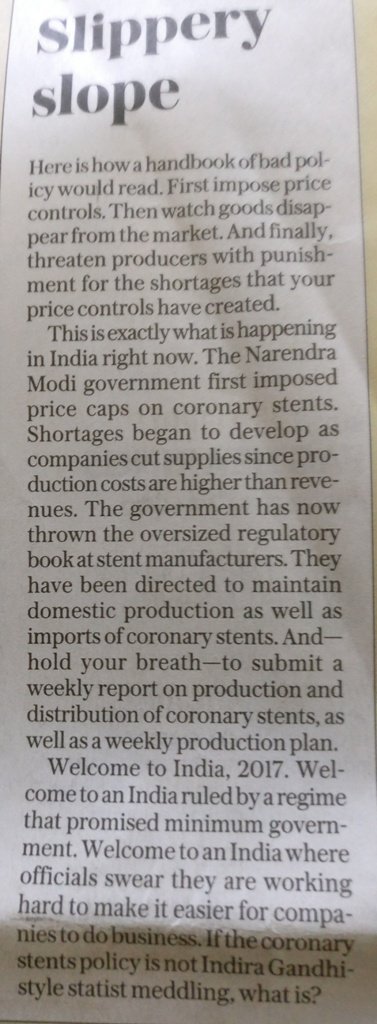National Pharmaceutical Pricing Authority’s move to cap pricing of coronary stents would adversely affect well-to-do patients and medical tourism industry in India
After the Delhi High court passed the order to slash the price of stents, National Pharmaceutical Pricing Authority (NPPA), a government regulatory agency issued a order on 13th Feb, 2017. This order came as a boon for the BJP Government which was busy with their UP & BMC campaign. PM Narendra Modi made it sure, that price capping of stents becomes an USP during his election speeches. Neither the Government nor the NPPA took suggestions from doctors, hospitals before issuing new regulations.
To summarise, stents were capped in 2 broad categories.
1. Bare Metal Stents – Rs.7260
2. Drug Eluting Stents and Bioresorbable Vascular Scaffold/Biodegradable Stents – Rs.29600
As of now, Abbott and Medtronic have filed for withdrawal of their premium coronary stents from the Indian market, as it wasn’t commercially viable after the price cap. Boston Scientific might withdraw their premium stents too after the completion of their corporate sustainability review. Now Indian patients won’t have access to high end stents even if they are ready to spend money. Government has every right to make doctors work for the poor, but they can’t deprive middle and upper class of what they can buy. This is not beneficial for a democracy. This is extreme health care rationing. Bare metal stents could be made of stainless steel, cobalt or platinum. The pricing of these differs.
It’s the basic law of economics. If tomorrow, Government decides to put a price cap of Rs.30,000 on smartphones. Then Apple will only sell older iPhone models like SE, 6 and won’t sell newer 7, 7S models.
To make matters worse, NPPA has rejected the withdrawal plea of Abbott and Medtronic. They also directed stent manufacturers to have stock for 6 months or face action. Basically forcing them to sell their high end products at a loss. This lame restriction could be easily evaded by importing only basic stents while not importing premium stents. Imagine, Mercedes Benz being forced to sell their high end car for Rs. 10 lakhs. This is borderline insanity, Government can’t dictate companies to sell their non-essential, premium products at a specific price. This isn’t North Korea.
If Government is serious of public healthcare in India then why does it spend a meagre 1.4% of the GDP on healthcare? Because that doesn’t favour their PR based governance. BJP’s print advertisement on the eve of BMC election read, “expensive angioplasty stent now cheaper by 85%; decision of a sensible government”. Modi Government isn’t interested in reforms and instead prefers managing headlines over economy.
What should the Government have done to help the poor as well as to not harm the middle/upper class?
1. Create 4 classes of stents instead of current 2 classes.
2. Leave the last one uncapped, so those who could afford have access to newer tech.
3. Adopt an ala carte approach, making available stents at Rs. 7000, Rs. 28000, Rs. 85000 and uncapped.
4. Provide first two only through RGJAY and other schemes.
5. Use the expertise of public sector rate contracts and declare the rates at which all varieties of stents can be bought into India. Get these prices in public domain for everyone’s knowledge and information.
6. Audit the procedures in public and private hospitals through a third party.
7. Audit individual cardiologist’s annual performance to know for which class he is working more.
8. Consider SEZs for implant companies to manufacture these high end products in India.
These suggestions were provided by Dr. Sanjay Oak in his article in Mumbai Mirror.
This is how a handbook of bad policy would read. First, impose price controls. Then watch goods disappear from the market. And finally threaten producers with punishment for the shortages that your price controls have created. Multi-speciality hospitals across the country are reporting a fall in foreign patients due to shortage of premium stents. Patients are instead getting operated in Singapore, Bangkok. Thanks to this move, we are now losing valuable foreign currency too. Why is Indian Gov’t promoting reverse medical tourism? Undoubtedly we need to care more for our poor, but we can’t at the same time ignore the desires of millions of people who belong to upper and middle class and who are honest tax payers. Why should they be denied a choice?
Today it’s cardiac stents, tomorrow it will be orthopaedic implants, and after that, maybe oncology drugs. There is no doubt that the government’s intentions are laudable and the efforts are an attempt to ensure equitable distribution of medical care and to curb medical malpractices. But the execution is misdirected and mal-aligned. Hospitals may hike cath lab rent per procedure and try to bridge the gap. Surgeons may prefer bypass surgical procedures. All these regulations appear as knee-jerk reactions done to control medical malpractice. I am not claiming here that everything was hunky-dory in the stent and implant business. But, putting a cap on prices is not the answer to the problem.
While Modi led BJP came to power with the slogan of, “Minimum Government, Maximum Governance”. Their actions are nowhere near it. Instead the License Raj that we left off in the 1980s, is making a comeback.


Author clearly doesn’t have medical knowledge and trying to sensationalise the issue.. Go read US FDA warning on these stents all US cardiologist have already stopped using it.. Its more of covering up act by abott as both the stents which it is withdrawing in name of commercial unviability is actually shown to be more dangerous.. So wants to quitely withdraw and stop production.. The other drug eluting stents are still available..